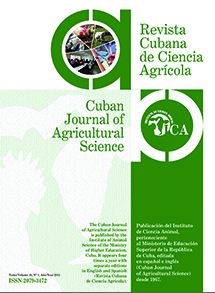Evaluation of non-linear and mixed non-linear models to describe in vitro gas production kinetics of ruminant feeds
Contenido principal del artículo
Resumen
The performance of non-linear and mixed non-linear models was evaluated in the description of in vitro gas production kinetics of ruminant feeds. For this, the logistic, Gompertz and Groot models were used. The analyzes included the addition of random effects to the asymptotic parameter of each model, since this parameter was the one that varied the most among the incubation bottles. Each random effect was associated with a probable source of variability in the experiment. The parameters were estimated with the NLMIXED proc of SAS program. For the selection of the best fit model, the R2aj, σ2, AIC and BIC were considered. In addition, compliance with the basic assumptions for the residuals and the relationship among mathematical fit, simplicity and biological interpretation of the parameters were assessed. It is concluded that the non-linear mixed models allowed to obtain better R2aj, BIC and σ2. The random effects had no significant effect on the fulfillment of the assumptions of autocorrelation and randomness of residuals. The random effect bottle over time allowed to determine the times in which there was a lack of fit. Despite the limitations of the analyzed models, the logistic, without the inclusion of the random effect, was the most appropriate according to the parsimony criterion.
Keywords: mathematical modeling, random effect, goodness of fit, parsimony, fermentation
Keywords: mathematical modeling, random effect, goodness of fit, parsimony, fermentation
Detalles del artículo
Cómo citar
García Avila, Y., Herrera, M., Rodríguez, R., & Ontivero, Y. (2022). Evaluation of non-linear and mixed non-linear models to describe in vitro gas production kinetics of ruminant feeds. Cuban Journal of Agricultural Science, 56(1). Recuperado a partir de https://mail.cjascience.com/index.php/CJAS/article/view/1040
Sección
Biomatemáticas
Aquellos autores/as que tengan publicaciones con esta revista, aceptan los términos siguientes:
- Los autores/as conservarán sus derechos de autor y garantizarán a la revista el derecho de primera publicación de su obra, el cuál estará simultáneamente sujeto a la Licencia Creative Commons Attribution-NonCommercial 4.0 International (CC BY-NC 4.0) que permite a terceros compartir la obra siempre que se indique su autor y su primera publicación esta revista. Bajo esta licencia el autor será libre de:
- Compartir — copiar y redistribuir el material en cualquier medio o formato
- Adaptar — remezclar, transformar y crear a partir del material
- El licenciador no puede revocar estas libertades mientras cumpla con los términos de la licencia
Bajo las siguientes condiciones:
- Reconocimiento — Debe reconocer adecuadamente la autoría, proporcionar un enlace a la licencia e indicar si se han realizado cambios. Puede hacerlo de cualquier manera razonable, pero no de una manera que sugiera que tiene el apoyo del licenciador o lo recibe por el uso que hace.
- NoComercial — No puede utilizar el material para una finalidad comercial.
- No hay restricciones adicionales — No puede aplicar términos legales o medidas tecnológicas que legalmente restrinjan realizar aquello que la licencia permite.
- Los autores/as podrán adoptar otros acuerdos de licencia no exclusiva de distribución de la versión de la obra publicada (p. ej.: depositarla en un archivo telemático institucional o publicarla en un volumen monográfico) siempre que se indique la publicación inicial en esta revista.
- Se permite y recomienda a los autores/as difundir su obra a través de Internet (p. ej.: en archivos telemáticos institucionales o en su página web) antes y durante el proceso de envío, lo cual puede producir intercambios interesantes y aumentar las citas de la obra publicada. (Véase El efecto del acceso abierto).
